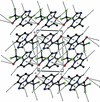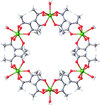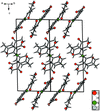issue contents
January 2022 issue

Cover illustration: The unnatural β-amino acid baclofen can be used to treat spastic movement disorders or alcohol dependence and is applied as a racemic mixture. New synthetic routes towards the active (R)-enantiomer now make it possible to determine its molecular and crystal structure. Strong N—H ⋯O/Cl and C—H⋯Cl/π interactions connect the zwitterionic molecules. See: Belov, Villinger & von Langermann [Acta Cryst. (2022). E78, 33–35].
Jerry P. Jasinski tribute
Download citation


Download citation


The X-ray crystal and molecular structures, DFT study and Hirshfeld surface analysis of a novel spirobicyclic diselenide are reported.
CCDC reference: 2127961
research communications
Download citation


Download citation


The pyridazine ring in the molecule of the title compound adopts a screw-boat conformation. The whole molecule is flattened, the dihedral angles subtended by the least-suares plane of the central aromatic ring with those of the terminal benzene and pyridazine rings being 15.18 (19) and 11.23 (19)°, respectively. In the crystal, the molecules are linked by pairs of N—H⋯O bonds into centrosymmetric dimers and by C—H⋯π contacts into columns.
CCDC reference: 2123627
Download citation


Download citation


In the crystal, the molecules are linked by C—H⋯N and C—H⋯O hydrogen bonds into strips, which are connected by F⋯F contacts into layers.
CCDC reference: 2124974
Download citation


Download citation


A dicationic PdII dimer containing a [2-(methylenphosphanyl)-8-thiolatequinoline] pincer ligand was isolated and its crystal structure determined.
CCDC reference: 2124311
Download citation


Download citation


The molecular and crystal structures of two dihydrofurylsilanes are reported. A Hirshfeld surface analysis was performed to investigate the intermolecular interactions.
Download citation


Download citation


3-(Hydroxymethyl)-3-methyl-2,6-diphenylpiperidin-4-one was synthesized by condensing 4-hydroxy-3-methyl-2-butanone with the benzaldehyde and ammonium acetate. In the crystal, the molecules are linked by O—H⋯O and C—H⋯O hydrogen bonds into double ribbons.
CCDC reference: 2124980
Download citation


Download citation


The first single-crystal XRD-based structure of enantiopure (R)-baclofen, a commonly used spasmolytic drug, without any co-crystallized molecules is reported in this article.
CCDC reference: 2125567
Download citation


Download citation


N,N,N′,N′-tetramethylethanediamine, C6H16N2, crystallizes in the monoclinic crystal system in the space group P21/c. For the investigation of the conformation, quantum chemical methods were used and for intermolecular interactions, a Hirshfeld surface analysis was performed.
CCDC reference: 2123810
Download citation


Download citation


[UO2(acac)2(H2O)] is constructed from one uranyl(VI) unit, two monoanionic acetylacetonate (acac) ligands and one aqua ligand. The U atom exhibits a UO7 distorted pentagonal–bipyramidal coordination geometry; four O atoms from two chelating bidentate acac ligands and one O atom of a aquo ligand (Ow) form the equatorial plane while two uranyl(VI) O atoms are located at the axial positions.
CCDC reference: 2117155
Download citation


Download citation


The air- and moisture-sensitive title compound was synthesized from tris(cyclopentadienyl)(tetrahydrofuran)terbium and 2-{[(2-methoxyphenyl)imino]methyl}phenol. Each Tb atom is coordinated by two cyclopentadienyl ligands in an η5-coordination mode and by one N and two O atoms of the organic ligand in a tridentate κ3O,N,O′-mode.
CCDC reference: 2127087
Download citation


Download citation


The crystal structure of the title compound comprises two independent molecules that mainly differ in the orientation of the phenyl ring to the rest of the molecule.
CCDC reference: 2127513
Download citation


Download citation


The title compound, a salt form of (E)-2-benzyl-1,3-diphenylisothiouronium iodide, was prepared by the reaction of 1,3-diphenylthiourea and benzyl iodide. In the crystal, N—H⋯I hydrogen bonds link the components into [100] chains.
CCDC reference: 2127354
Download citation


Download citation


The condensation products of the o-, m- and p- isomers of aminobenzoic acid and 3-formylaceylacetone were synthesized and structurally characterized. As a result of the different substitution patterns, their crystal structures are governed by different types of hydrogen-bonding motifs.
Download citation


Download citation


Three crystal structures from the reaction of 2,6-dimethylphenyl isocyanide with bis(anthracene)ferrate(−1) are presented.
Download citation


Download citation


The crystal structure of both compounds consists of discrete complexes with terminal N-bonded thiocyanate anions in which the Co cations are sixfold coordinated within slightly distorted octahedra, which are linked by intermolecular hydrogen bonding, in one compound via additional urotropine solvate molecules, into three-dimensional networks.
Download citation


Download citation


The crystal structure of the title compound consists of discrete tetrahedral complexes, which are linked by intermolecular N—H⋯S and C—H⋯S hydrogen bonding into chains.
CCDC reference: 2128608
Download citation


Download citation


The short RE⋯RE interatomic distance is a common structural feature of rare-earth trirhodium diborides RERh3B2 (Pr, Nd, and Sm). The crystal-structure redeterminations using single-crystal X-ray data revealed that the displacement ellipsoids of Rh and RE atoms elongated along the c axis are attributed to the unusually short RE⋯RE interatomic distances. Moreover, the anisotropic ellipsoids of Rh and RE could be associated with the appearance of disordered La1–xRh3B2-type and/or Nd1–xRhxRh3B2-type structures.
Download citation


Download citation


The title compound was synthesized by a new method at the interphase of aqueous solutions of LiOH and pentafluorophenylacetonitrile. In the crystal, hydrogen bonds and π–halogen interactions connect the molecules into double layers. The Hirshfeld surfaces of analogues of the title compound were compared and the effect of perfluorination on the crystal packing was shown.
CCDC reference: 2128969
Download citation


Download citation


The title compound is a Schiff base that exists in the phenol–imine tautomeric form. The molecular structure is stabilized by an O—H⋯N hydrogen bond, forming an S(6) ring motif.
CCDC reference: 2128953
Download citation


Download citation


The title Schiff base adopts an E configuration. The molecular structure is stabilized by an C—H⋯O and C—H⋯N hydrogen bonds.
CCDC reference: 2129693
Download citation


Download citation


A new potentially chelating bulky bis(alkoxide) exhibits anti conformation of the O-atom donors in the solid state and does not form transition-metal complexes.
CCDC reference: 2129676


 journal menu
journal menu








































